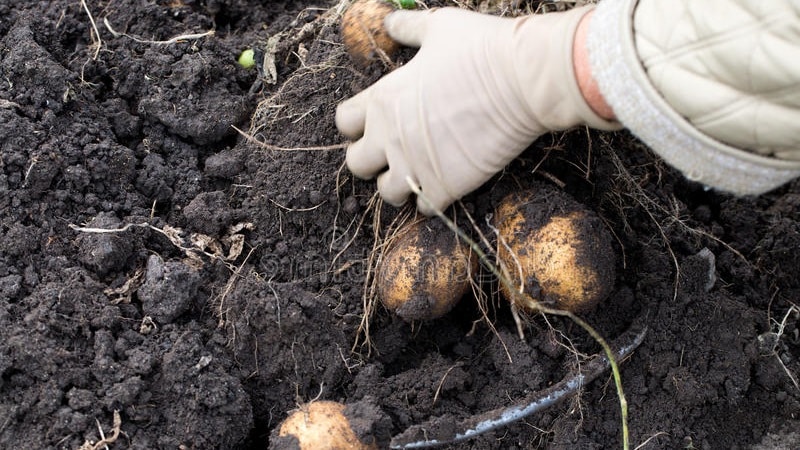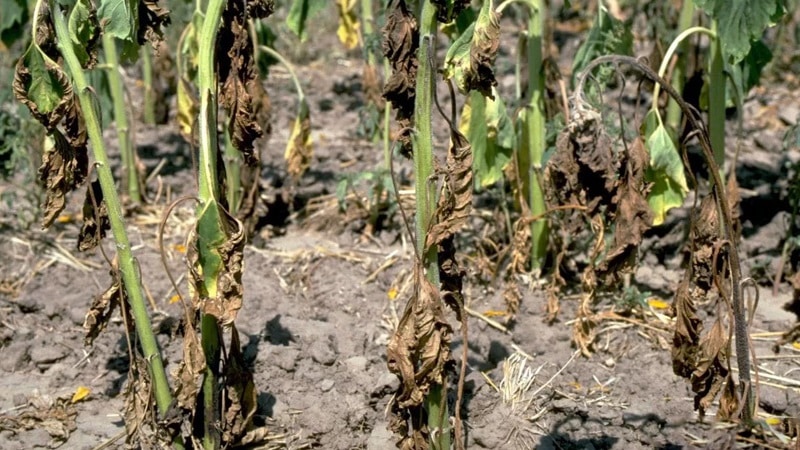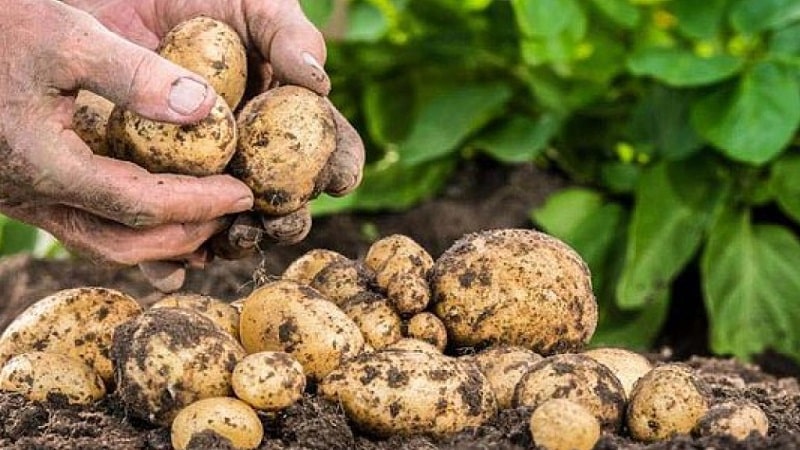Is it possible to eat soft potatoes and why do they wither in the ground?
If, when harvesting potatoes, you come across limp, wrinkled tubers, the reason for this may be both weather conditions and fungal diseases. Gardeners say: the potatoes are boiled in the ground. Whatever the reason for this phenomenon, such a crop cannot be stored.
Why do potatoes become soft and limp when dug up?
There are many reasons that lead to damage to tubers in the ground. The same processes occur in them as during long-term storage in a warm place. Potatoes lose moisture, which leads to dehydration at the cellular level. The tubers remain round on the outside, but flaccid on the inside.

Why do potatoes wither in the ground?
Lethargy of tubers in the ground by the end of the growing season is possible for several reasons. Let's look at the most common ones.
Reference. Sometimes tubers wither due to the wrong variety: some are not suitable for sowing in the southern regions, others grow poorly in the northern regions.
Weather
In adverse weather conditions the tops wither, and this negatively affects the tubers:
- Dry weather. In arid regions, it is important to provide plantings with timely watering, especially during the period of flowering and bud formation.
- Sudden changes in temperature. In many regions, by the end of summer, the temperature at night drops to +5...+7°C, which is why the tops turn black and wither.
- Heavy rains. High soil moisture leads to premature wilting of tubers.Stagnant water does not allow oxygen to reach the roots, and the plant begins to wither or rot.
Diseases
The most common diseases that lead to tuber wilting include:
- Brown bacteriosis. Sources of infection include insects, rainwater or dirty garden tools. Once the bacteria reach the tubers, blood clots form. Potatoes stop receiving moisture, which leads to wilting.
- Verticillium wilt. The crop becomes infected during flowering, the disease affects the lower part of the tops. The vessels of the vegetable crop become blocked, the leaves and stems become covered with dark spots. Moisture stops flowing to the leaves, they wither and fall. Early varieties are saved by urgently digging up tubers.
- Silver scab. The fungus infects potatoes between the periderm and epidermis; due to lack of moisture, air cavities appear. The tubers do not rot, but become light and soft. Depending on the degree of damage, potatoes may wilt after harvesting and storing the crop for the winter. Over time, the affected areas acquire a silvery tint.

Pests
Some insects damage the stems and roots of the plant, which leads to disruption of the vascular system and the process of photosynthesis. As a result, the tops dry out, the tubers stop growing and wither.
Among potato pests:
- Colorado beetle. Found in almost every garden. Insect larvae are dangerous because they eat green foliage during growth, leaving bare stems.
- Stem nematode affects the tubers and roots of the plant. It is difficult to detect - the size of the worms does not exceed 1.5 mm. They are capable of destroying up to 4 hectares of crops.
Lack of microelements and unsuitable soil
Soil quality directly depends on atmospheric conditions. When the soil dries out, it becomes covered with cracks, which leads to even greater loss of moisture. Too wet soil does not allow air to pass through, as a result of which the plant experiences oxygen starvation, withers and dies.
From sandy soil, precipitation quickly washes out nitrogen in an easily digestible form. Due to a lack of microelements (potassium, nitrogen, boron, manganese, magnesium and calcium), the tubers wither and the leaves turn yellow.
Important! Improper watering is one of the reasons for potato wilting. The plant needs moisture during germination, flowering and budding.
Is it possible to eat soft potatoes?
Closer to spring, potatoes become soft and tasteless. She loses useful material, but you can eat it without harm to your health. If the reason for potato wilting is weather conditions or lack of nutrients, it is suitable for consumption. Damage to tubers is a symptom of fungal or viral diseases. Such potatoes are dangerous to health.
Prevention
To get a big harvest experienced agronomists recommend carrying out preventive measures several times: before planting potatoes, during growth and after harvesting.

Proper agricultural technology
Agrotechnical practices improve crop quality:
- Every year It is recommended to follow the rules of crop rotation. It is better not to plant cucumbers, tomatoes, eggplants and peppers next to potato beds.
- Optimal planting dates vary. Sprouted tubers are planted when birch buds bloom. By this time the earth has time to warm up.
- The amount of harvest is also depends on the density of the bed. No more than 5-7 bushes are planted per 1 m².
- Important destroy weeds in a timely manner. They spread diseases, take away moisture and nutrients, and shade plantings.
- During the formation of buds, increase watering and periodically loosen the soil.
Disease Control
Diseases can be avoided if certain rules are followed.:
- Carefully check the seed material and change every 3-4 years.
- Before planting, treat the tubers potassium permanganate or copper sulfate (dilute 5 g of powder in 3 liters of water).
- Sprouted tubers produce solanine, which increases resistance to certain diseases. To germinate, just hold the seeds under the sun or an ultraviolet lamp.
- In a timely manner inspect the bushes, if the first signs are present, treat immediately their fungicidal agents “Fitosporin”, “Quadris”, "Prestige".
- After harvesting, collect the stems and burn them. You should not leave rotten potatoes in the garden.
Pest Control
Pests easily move from one area to another and can destroy the entire crop. You can prevent the appearance of the Colorado potato beetle in the following way::
- Selection of resistant varieties (Temp, Spark, Diamond, Platinum).
- Manual beetle assembly. The female lays about 400 eggs per season, so the destruction of 1 adult significantly reduces the spread of larvae in the area.
- Chemical treatment is carried out if the attack is massive. Stems and leaves are treated with solutions of Colorado, Sumicidin, Actellik.
- If a nematode lesion is identified, damaged plants are dug up and burned. Work shoes and equipment are treated with formaldehyde.
Feeding
To form 10 kg of healthy tubers, the following fertilizers are applied in stages::
- Before boarding. If the soil is clayey, add humus; if it is peaty, add a sandy substrate.
- At the end of May – nitrogenous mixtures.
- During the formation of buds – potash fertilizers (potassium sulfate, wood ash).
- During the flowering period – phosphorus (superphosphate).
- When dry the stem and leaves are sprayed with the immunostimulant "Baktofit".
Conclusion
Potatoes need timely watering and fertilizing, and they are often affected by fungal diseases and pests. Yellowed or curled leaves indicate that the bush will soon die.
To prevent such problems, follow the rules of agricultural technology, apply fertilizers in a timely manner, hill up the beds and monitor crop rotation.